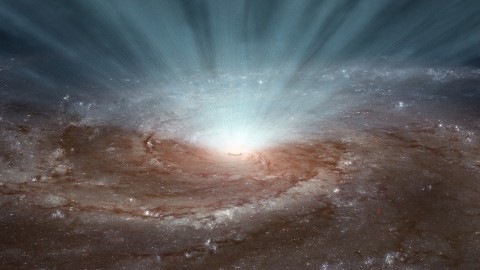NASA and ESA Calculate Winds from Supermassive Black Holes
| Marco Foronda | | Feb 21, 2015 08:27 AM EST |
(Photo : NASA/JPL-Caltech) Supermassive black holes at the cores of galaxies blast radiation and ultra-fast winds outward, as illustrated in this artist’s conception.
For the first time, researchers from NASA and the European Space Agency (ESA) have quantified the speed, shape and size of the winds surrounding black holes, allowing them to figure out how these forces impact their galaxies.
Using NASA's Nuclear Spectroscopic Telescope Array and the ESA's XMM-Newton telescope, researchers from Caltech and Keele University of England were able to measure the speed, shape, and size of the winds blasting out from PDS 456-a super bright black hole located two billion light years away.
Like Us on Facebook
PDS-456, the black hole at the center of this study, is a unique phenomenon in astronomy. It's close enough to Earth for a good look, but unlike other bodies, it's a rare "supermassive black hole". This type of black hole was much more common 10 billion years ago, not long after the Big Bang.
"These gusts are completely ionized. Every element is completely stripped of its electrons; the only element that is left is iron. If iron is in front of the black hole, it blocks the radiation from the black hole, so we see a dip in the intensity of the light coming from the black hole," said Emanuele Nardini, lead author of the study.
By observing the patterns of iron in front of the black hole and at its sides, researchers were able to determine these winds push out in every direction from the black hole. And these winds are incredibly fast, traveling at one-third the speed of light. They also carry more energy every second than the energy that would be emitted by a trillion suns.
The details of the study were published in the journal Science.
TagsNASA, ESA, super massive black hole, PDS-456, XMM-Newton telescope, Nuclear Spectroscopic Telescope Array, space exploration
©2015 Chinatopix All rights reserved. Do not reproduce without permission
EDITOR'S PICKS
-

Did the Trump administration just announce plans for a trade war with ‘hostile’ China and Russia?
-

US Senate passes Taiwan travel bill slammed by China
-

As Yan Sihong’s family grieves, here are other Chinese students who went missing abroad. Some have never been found
-

Beijing blasts Western critics who ‘smear China’ with the term sharp power
-

China Envoy Seeks to Defuse Tensions With U.S. as a Trade War Brews
-

Singapore's Deputy PM Provides Bitcoin Vote of Confidence Amid China's Blanket Bans
-

China warns investors over risks in overseas virtual currency trading
-

Chinese government most trustworthy: survey
-

Kashima Antlers On Course For Back-To-Back Titles
MOST POPULAR
LATEST NEWS
Zhou Yongkang: China's Former Security Chief Sentenced to Life in Prison

China's former Chief of the Ministry of Public Security, Zhou Yongkang, has been given a life sentence after he was found guilty of abusing his office, bribery and deliberately ... Full Article
TRENDING STORY

China Pork Prices Expected to Stabilize As The Supplies Recover

Elephone P9000 Smartphone is now on Sale on Amazon India

There's a Big Chance Cliffhangers Won't Still Be Resolved When Grey's Anatomy Season 13 Returns

Supreme Court Ruled on Samsung vs Apple Dispute for Patent Infringement

Microsoft Surface Pro 5 Rumors and Release Date: What is the Latest?










